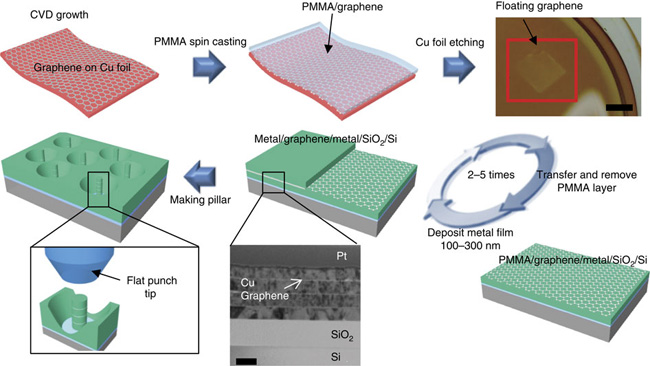A new metamaterial has been developed exhibiting hundreds of times greater strength than pure metals. Professor Seung Min, Han and Yoo Sung, Jeong (Graduate School of Energy, Environment, Water, and Sustainability (EEWS)) and Professor Seok Woo, Jeon (Department of Material Science and Engineering) have developed a composite nanomaterial at the Korea Advanced Institute of Science and Technology (KAIST).
The nanomaterial consists of graphene inserted in copper and nickel and exhibits strengths 500 times and 180 times, respectively, greater than that of pure metals. The result of the research effort was published in Nature Communications. Graphene displays strengths 200 times greater than that of steel, is stretchable, and is flexible.
The U.S. Army Armaments Research, Development and Engineering Center developed a graphene-metal nanomaterial but failed to drastically improve the strength of the material.
To maximize the increase in strength imparted by the addition of graphene, the KAIST research team created a layered structure of metal and graphene. Using CVD (Chemical Vapor Deposition) the team grew a single layer of graphene on a metal deposited substrate then deposited another metal layer and repeated the process to produce a metal-graphene multilayer composite material that, achieving a world first in doing so, utilized single layer of graphene. Micro-compression tests within Transmission Electronic Microscope and Molecular Dynamics simulation effectively showed the strength enhancing effect and the dislocation movement on an atomic level.
The mechanical characteristics of the graphene layer within the metal-graphene composite material successfully blocked the dislocations and cracks from external damage from traveling inwards. Therefore the composite material displayed strength beyond conventional metal-metal multilayer materials.
The copper-graphene multilayer material with an interplanar distance of 70nm exhibited 500 times greater (1.5GPa) strength than pure copper and nickel-graphene multilayer material with an interplanar distance of 100nm showed 180 times greater (4.0GPa) strength than pure nickel. It was found that there is a clear relationship between the interplanar distance and the strength of the multilayer material. A smaller interplanar distance made dislocation movement more difficult and therefore increased the strength of the material.

Professor Han, who led the research effort, commented “the result is astounding as 0.00004% in weight of graphene increased the strength of the materials by hundreds of times” and that “improvements based on this success, especially enabling mass production with roll-to-roll process or metal sintering process, in the production of automobile and spacecraft lightweight, ultra-high strength parts may become possible.”
In addition Professor Han mentioned that “the new material can be applied to coating material for nuclear reactor construction or other structural materials requiring high reliability.” The research effort received support from National Research Foundation, Global Frontier Program, KAIST EEWS-KINC Program and KISTI Supercomputer and was a collaborative effort with KISTI (Korea Institute of Science and Technology Information), KBSI (Korea Basic Science Institute), Stanford University, and Columbia University.
Source: KAIST
Figure reprinted by permission from Macmillan Publishers Ltd: Kim Y, Lee J, Yeom MS, Shin JW, Kim H, Cui Y, Kysar JW, Hone J, Jung Y, Jeon S, Han SM. 2013. Strengthening effect of single-atomic-layer graphene in metal-graphene nanolayered composites. Nature Communications 4. http://dx.doi.org/10.1038/ncomms3114, copyright 2013.
